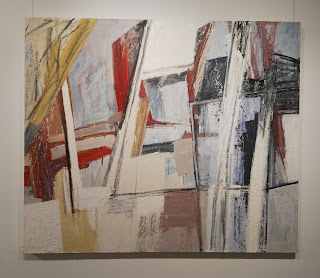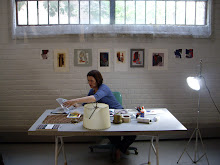Dates: Friday 27 September -
Saturday 19 October 2019
Opening: Friday 27 September 2019 ( 6- 8pm)
BMGART
Location: 444
South Road, Marleston, SA 5033.
Phone: +61 8 8297 2440
email: art@bmgart.com.au
Phone: +61 8 8297 2440
email: art@bmgart.com.au
Title : Loss #5
Medium: mixed media on canvas
Dimensions: 200cm W x 170 cm H
Date: 2018 - 2019
Title
: Move
Medium:
mixed media on canvas
Dimensions:28.5 ( W) x 28.5cm
(H) ( framed size)
Date:
2019
Title: IAM
#3
Medium:
mixed media on canvas
Dimensions: 170cm (H) x 200cm (W)
Date:
2018
Fiona Halse’s
series of large paintings, smaller paintings
and collages explore Matisse’s
statement that ‘Black is a force’ (Flam,
J, 1978 p. 106). Halse uses enamel black
paint to create structural tensions and collision of forms, but black is also used in a similar manner to Matisse
to ‘simplify the construction’ (Flam,
J, 1978). The majority of paintings in the exhibition utilises black to
create depth, heavy textures, linear forceful scaffolds and haptic marks. Halse has included one lighter painting as a
contrast where black functions as a linear architectonic construct.
Halse’s
work seeks to convey a personal space that is
metaphorically associated with the human figure. Her forms seek to capture
the visceral and her abstract works connect to an essence that is not described
but sensed. Projection of self is
generalised and reduced through expressive abstract forms. Halse’s use of black does not seek to
convey bleakness - darkness can be nuanced and can be associated with infinity,
assertiveness, resilience and ambiguous void.
Flam, J, 1978,
Matisse On Art, E. P. Button New York, p. 106
Ideas relating to Black
Matisse, Black is a Colour (1946)
Black is a Colour (1946)
Before, when I didn’t know what colour to put down, I put down
black. Black is a force. I depend on black to simplify the construction. now
I’ve given up blacks. The use of Blacks as a colour in the same way as the
other colours –yellow, blue, or red is not a new thing.
The Orientals made use of black as a colour, notably the Japanese
in their prints. Closer to us all, I recall a painting by Manet in which the
velvet Jacket of a young man with a straw hat is painted in a blunt lucid black.
In the portrait of Zacharie Astruc by Manet, a new velvet jacket
is also expressed by a blunt luminous black. Doesn’t my painting of the
Morocains use a grand Black which is as luminous as the other colours in the
painting.
Like all evolution, that of black in painting has been made in
jumps. but since the Impressionists it seems to have made continuous progress,
taking a more and more important part in colour representation, comparable to
that of the double-bass as a solo instrument.
Reference - Essay from the book: Matisse On Art – by Jack D. Flam
Reference
- Flam, J, 1978, Matisse On Art, E. P. Button New York, p. 106
Renoir called black ‘the queen of
colours’
Reference - Vollard, Renoir:
An Intimate Record, trans. H. L.
Tintoretto’s ‘the most beautiful
of all colours is black
Reference - Eric Potter,
ed., Painters on Painting (New York, 1971), pp. 53–4.
The ambiguity of black – is it
thick stuff or nothingness, a colour or darkness? – has helped
it to carry other opposite
values: fertile soil or burned cinders; smart clothes or widow’s weeds; the
sexual mysteries of the night or death, depression and grief.
Reference - Harvey, J.
(2013). The story of black.
Other ideas that relate to
black:
My works created in Spain - Can
Serrat Art Center - http://www.visualartist.info/fionahalse/can-serrat-international-art-centre-spainnbspnbsp2006-residency
Other related ideas:


















No comments:
Post a Comment